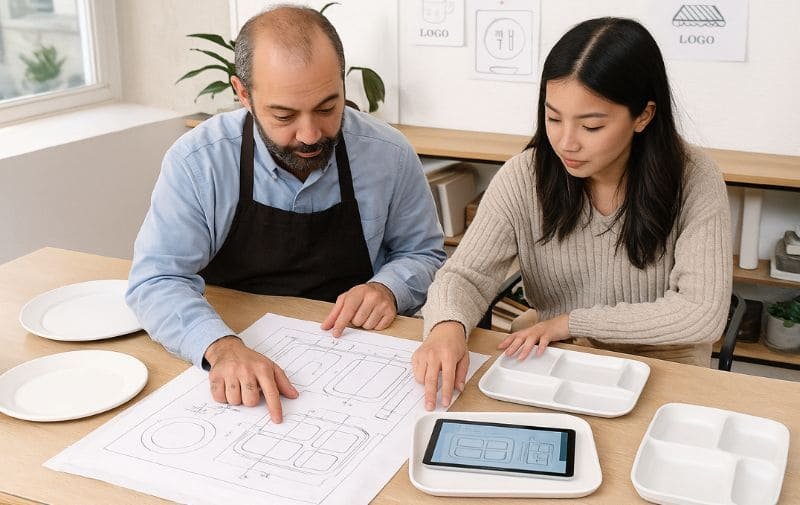You have a vision for your restaurant, café, or brand: a beautifully designed serving tray that carries not just food, but your unique identity. The question is, how do you turn that vision into a physical product, especially when dealing with overseas manufacturers?
To create custom melamine trays, you must find a reliable supplier, understand the step-by-step process from design to delivery, and learn the industry secrets behind Minimum Order Quantities (MOQs), materials, and shipping. The key is to partner with a factory that can guide you through choosing the right shape, material, and artwork to create a durable, food-safe, and brand-defining product.
The process can seem daunting, but it’s more accessible than you think. While off-the-shelf options exist, true brand distinction comes from customization. This guide will walk you through every stage, from finding the right partner to ensuring the quality of your final product, demystifying the industry jargon and insider knowledge you need to succeed.
Last Updated: Oct 1th 2025 | Estimated Reading Time: 12 Minutes
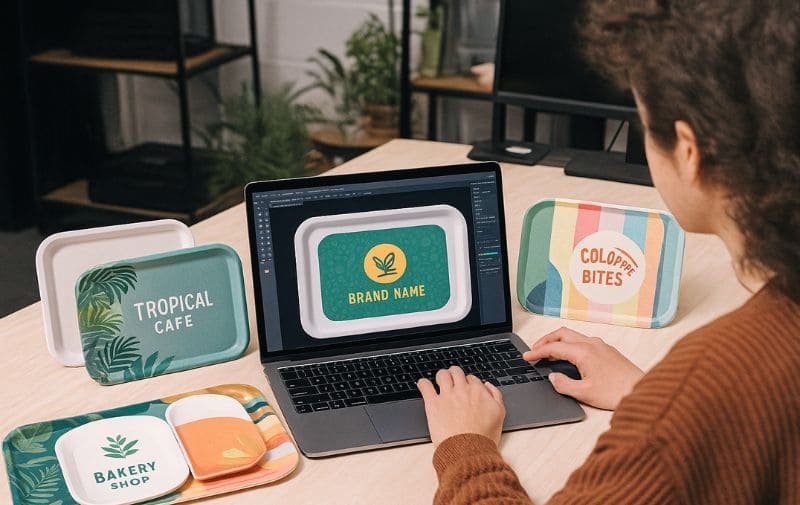
Should You Customize or Buy Off-the-Shelf?
Your first major decision is whether to buy ready-made trays or create something unique. The right choice depends entirely on your business needs, volume, and brand strategy.
Buy off-the-shelf trays from online retailers if you need a small quantity quickly and don’t require specific branding. For a unique design, logo, or shape that enhances your brand identity, you must find a dedicated supplier to handle custom manufacturing.
A Quick Comparison: Stock vs. Custom
| Feature | Off-the-Shelf (e.g., Amazon, Walmart) | Custom Manufacturing (Direct from Supplier) |
|---|---|---|
| Branding | Limited to existing designs and colors. | Fully customizable with your logo, colors, and full-bleed artwork. |
| Shape & Size | Restricted to available stock models. | Create a unique shape/size with an affordable mold (~$800). |
| Minimum Order | Can buy as little as one unit. | 1,000-3,000 pieces (MOQ). |
| Lead Time | Immediate shipping (a few days). | Manufacturing and shipping can take 2-3 months. |
| Unit Cost | Higher per-unit retail price. | Much lower per-unit wholesale price. |
| Best For | Startups, very small businesses, or immediate needs. | Established brands, restaurants, and businesses planning to scale. |
How Do I Find and Vet a Reliable Melamine Tray Supplier?
Finding the right partner is the most critical step. A great supplier is more than just a factory; they are a guide who helps you navigate the entire process.
Start Your Search
Use specific, commercial-intent keywords on search engines like Google or Bing:
- “custom melamine tray manufacturer“
- “melamine serving tray factory China”
- “wholesale personalized melamine trays”
- “melamine tray supplier for restaurant”
Once you have a list, vet them by asking key questions about their MOQ, material grades, testing history, and shipping capabilities.
Key Questions to Ask a Potential Supplier
- What is your Minimum Order Quantity (MOQ) per design?
It’s a simple question with a complex answer. - What material grades do you offer? (A5, A1, Bamboo Fiber)
A quality supplier will default to A5 for food-grade products. - Can you provide recent, unexpired LFGB or FDA test reports done for other US/EU clients?
This is more valuable than a generic factory certificate. - Can you quote me a DDP (Delivered Duty Paid) shipping price to my address?
This shows if they can handle a complete, door-to-door logistics solution. - What is the cost and lead time for a pre-production sample?
This is essential for final approval.
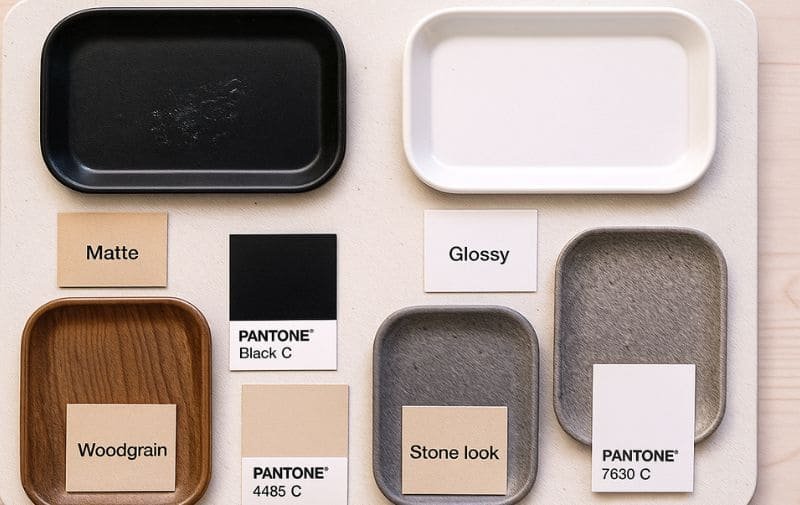
The Secret of Minimum Order Quantity (MOQ): It’s the Paper, Not the Tray
Suppliers often quote an MOQ of 3,000 pieces, which can be intimidating. The reason isn’t the tray itself; it’s the custom-printed decal paper. This paper is produced using an industrial gravure printing process. The setup cost is fixed, whether you print 1 sheet or 1,000. The minimum economical print run for this paper is typically 1,000 large sheets. This is the true source of the MOQ.
Deconstructing Certifications: The “Time Snapshot” Dilemma
Don’t just ask, “Do you have FDA certification?” It’s a low-information, yes/no question. A certification is tied to a specific product, using a specific color, at a specific time. It’s a time snapshot, not a permanent guarantee.
Instead, ask this: “Please send me 1-2 recent, unexpired LFGB test reports of your products conducted for any of your customers, preferably those from Europe or the USA.” This single question tells you everything:
- They consistently use certified-grade raw materials.
- They understand the rigorous testing process.
- They are actively working with clients who have high standards. A supplier’s history of passing tests is far more telling than a single, possibly outdated, certificate.
The Step-by-Step Process for Customizing Your Tray
Step 1: Choose Your Tray’s Size and Shape
Start by browsing your potential supplier’s existing catalog. Do they have a shape that meets 80% of your needs? Using an existing mold is the fastest and cheapest way to start.
Step 2: Create a Unique Shape (Your Brand’s DNA)
Manufacturing Insight: Don’t be afraid to create a custom mold. Unlike plastic injection molds which cost tens of thousands, a new melamine compression mold is incredibly affordable, typically $700-$900 USD. This is not an expense; it’s a permanent asset that defines your operational efficiency and brand experience.
A custom mold is your brand’s DNA. It controls more than just shape:
- A One-of-a-Kind Design: A custom mold allows you to create a tray in any shape you envision, breaking free from the standard rectangles and circles everyone else uses. This ensures your product is immediately recognizable and unmistakably yours.
- A Permanent Brand Stamp: While the top of the tray features your printed design, a custom mold allows you to engrave your logo directly into the bottom of the tray. This is a subtle, high-end touch that acts as a permanent mark of quality and ownership.
- The Perfect Fit for Your Needs: The most important benefit is creating a tray that is perfectly suited to its job. Need a specific depth for appetizers with sauce, or a unique width to fit your countertops? A custom mold makes it possible, ensuring the final product isn’t just beautiful, but is the ideal functional tool for your business.
Step 3: Choose Your Material (It’s a Brand Decision)
The choice between A5, A1, and Bamboo Fiber melamine is about more than just cost; it’s about the message your brand conveys through touch and feel.
| Material | Composition | Best For | The “Feel” & Brand Message |
|---|---|---|---|
| A1 Grade | Urea-Melamine Blend | Non-food items only (e.g., ashtrays). | Feels light, hollow, and “plasticky.” Signals “low-cost.” |
| A5 Grade | 100% Pure Melamine | All food applications. The industry standard for quality. | Satisfying weight and density. Smooth, hard surface feels like ceramic. Signals “durable” and “quality.” |
| Bamboo Fiber | 30-40% Bamboo + Melamine | Eco-conscious brands, cafes, casual dining. | Unique, slightly matte texture. Feels organic and warm. Signals “sustainability” and “natural.” |
Step 4: Submit Your Artwork and Approve the Mockup
Your design’s complexity is the biggest hidden cost driver in customization. You’ll need to provide your artwork in a vector format (like .AI or .EPS). Your supplier will then create a digital mockup for you to approve. The type of design drastically affects the labor cost:
| Design Type | Description | Application Process | Cost Impact |
|---|---|---|---|
| Spot Logo | A simple logo placed in the center or on the rim. | A small decal is applied quickly and easily by hand. | Base Cost. Fast and efficient. |
| Full-Wrap Design | The artwork covers the entire surface and wraps over the edges. | A large, precisely shaped decal must be meticulously applied by hand to avoid bubbles and misalignment. | Adds 15-30% to the unit cost. A highly manual and skilled labor process. |
Step 5: Get a Pre-Production Sample
Always invest in a physical sample. This is your only chance to check the color accuracy, print quality, and overall feel. A sample costs around $100 (which covers the custom decal plate setup) plus courier fees and takes about 8-12 days.
Step 6: Confirm Your Packaging Options
- Standard: Bulk packed with dividers, or each tray in a simple polybag, then placed in a master carton.
- Custom: Retail-ready options like individual white boxes, full-color printed gift boxes, or trays with custom belly bands. Be sure to provide detailed specifications for accurate pricing.
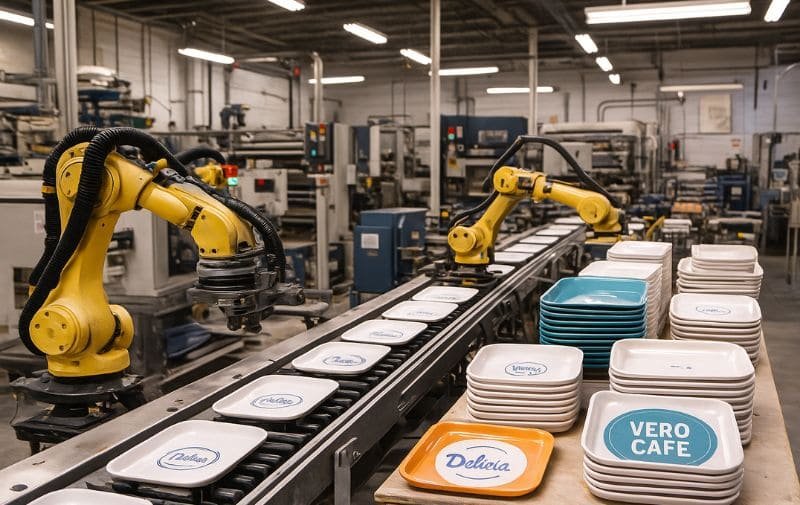
How Long Does It Take and What Are the Shipping Options?
Once production is complete, the final step is getting the trays to your door. For new importers, understanding shipping is crucial.
Sea freight is the most common and cost-effective shipping method, with transit times of 30-55 days. For urgent needs, air freight is faster (10-15 days) but significantly more expensive. Door-to-door (DDP) service is the simplest option for your first order.
Shipping At a Glance
| Method | Typical Transit Time (to USA/EU) | Cost | Best For |
|---|---|---|---|
| Sea Freight | 30-55 days | Baseline Cost | Most orders; planned inventory. |
| Air Freight | 10-15 days | 5-10x Sea Freight Cost | Urgent orders, samples, high-value goods. |
The “Convenience Trap” of DDP Shipping
DDP (Delivered Duty Paid) means the supplier handles everything—shipping, customs, and final delivery.
- For a first-time importer or one-time order, DDP is perfect. It’s easy and predictable.
- For a growing business that plans to reorder, DDP is a trap. You have no control or visibility over the process. You can’t choose your carriers to get better rates, and you’re in the dark if there are delays.
The Growth Path: Start with DDP for your first order. As you grow, transition to FOB, CIIF terms. This means you hire your own freight forwarder. It gives you control over your supply chain, better pricing, and direct communication, which are essential for building a scalable business.
How Can I Ensure the Quality of My Custom Order?
You’ve done everything right, but how do you guarantee the final product meets your standards before it leaves the factory overseas?
To ensure quality, you can request photos and videos of the factory’s internal QC tests (like the 60cm drop test) or hire an independent third-party inspection service for about $250 for complete peace of mind.
- The Standard Drop Test: The industry standard for a melamine tray is a drop from 60cm onto a hard surface. It should not crack, chip, or break. Ask your supplier for a video of them performing this test on a unit from your production run.
- Third-Party Inspection: For a fee of around $220-$275, you can hire a service like QIMA or SGS. A professional inspector will visit the factory, pull a random sample of your finished products, and perform a comprehensive check based on your criteria (checking for print defects, scratches, correct dimensions, etc.). They will send you a detailed report with photos within 24 hours. For any significant order, this is the best money you can spend.
Conclusion
Customizing melamine trays is a powerful way to elevate your brand. By choosing a flexible partner, understanding the secrets behind molds and MOQs, and making smart choices about materials and design, you can create a unique, durable, and cost-effective product that truly represents your business.
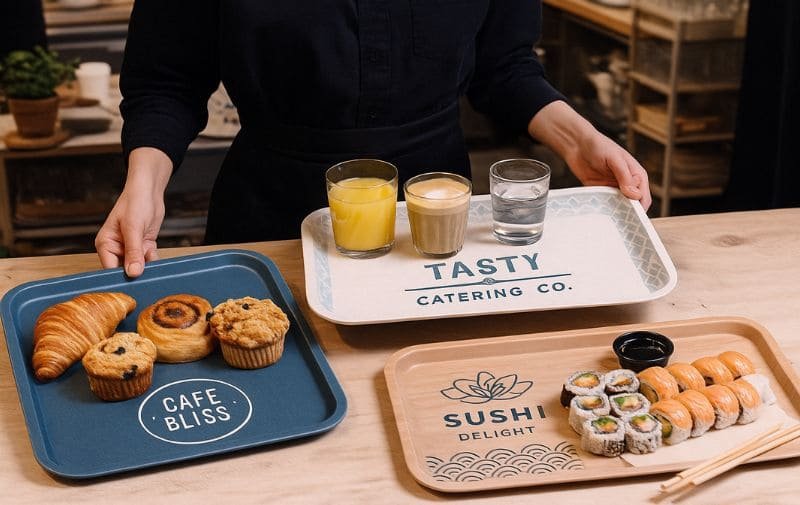
Frequently Asked Questions (F.A.Q.)
1. What file format do I need to provide for my logo or artwork?
You should always provide your artwork in a vector format, such as Adobe Illustrator (.AI), .EPS, or a high-resolution PDF. This allows the factory to resize your design without any loss of quality for creating the printing plates.
2. Can I order multiple designs if my total quantity meets the MOQ?
This depends on the supplier’s flexibility. Because the MOQ is driven by the decal paper print run, each unique design requires its own setup. Some suppliers may allow you to split the MOQ (e.g., 1,500 of Design A and 1,500 of Design B) but may charge an extra setup fee for the second design.
3. What is the difference between A5 and A8 melamine?
Functionally, for food-grade dinnerware, there is very little difference. A5 is the universally recognized standard for high-quality, 100% melamine. A8 is a similar formulation that some factories use. As long as the supplier can provide food-grade testing reports (like FDA or LFGB) for the material, both are considered premium and safe.
4. How are the custom designs applied to the trays? Are they stickers?
No, they are not stickers that can peel off. The design is printed onto special melamine decal paper. This paper is placed in the mold with the melamine powder. Under intense heat and pressure, the paper fuses permanently with the tray, becoming an integral part of the plastic itself.
5. If I pay for a custom mold, do I own it?
Yes, you own the intellectual property of the shape, and the physical mold is yours. A reputable supplier will store it for you and will not use it for any other client without your explicit permission. You can typically have the mold shipped to you if you ever decide to switch suppliers.
6. I am concerned about food safety. What should I look for?
Always insist on 100% A5 grade melamine for any surface that will touch food. The most important verification step is to ask the supplier for recent, unexpired food-grade test reports (FDA, LFGB, or Prop 65) that they have done for other clients in your target market (e.g., USA or EU). This demonstrates they consistently use safe, certified raw materials.
Recommended:
The Durability of Melamine Dinnerware: A Restaurant Owner’s Guide
Incoterms Explained: FOB vs. DDP for Small Business (Authoritative source on shipping terms)
QIMA – Third-Party Inspection Services (Example of a leading inspection company)

